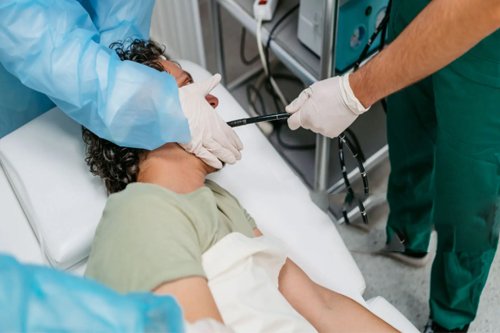Brain and ENT Clinic – Dr Lalit Mahajan In Nagpur & Dr Rachna Gangwani Mahajan In Nagpur
Hopkin Examination (Throat Endoscopy)

Throat endoscopy, also known as laryngoscopy, is a medical procedure that involves the use of an endoscope to examine the inside of the throat, including the larynx (voice box) and vocal cords. This diagnostic procedure allows healthcare professionals, particularly otolaryngologists (ear, nose, and throat specialists), to visually inspect the structures of the throat for abnormalities, such as inflammation, lesions, tumors, or other issues that may be affecting voice and swallowing function.
Throat endoscopy can help evaluate the vocal cords for conditions such as nodules, polyps, or paralysis that may affect voice quality.Assessing the function of the larynx and upper esophagus to identify issues contributing to difficulty swallowing.
Types of Throat Endoscopy
Flexible Laryngoscopy:
- A thin, flexible endoscope is passed through the nose and into the throat to visualize the larynx and vocal cords. This procedure is often done in an outpatient setting and does not require sedation.
Rigid Laryngoscopy:
- A rigid endoscope is used for a more detailed examination of the throat. It may be performed in an office setting or as part of a more extensive procedure, such as microlaryngoscopy, which may require general anesthesia.
Procedure
Preparation:
- For flexible laryngoscopy, no specific preparation may be needed. For rigid laryngoscopy or other procedures, the individual may need to fast for a certain period before the examination.
Administration of Anesthesia (if necessary):
- Flexible laryngoscopy is often done without anesthesia. Rigid laryngoscopy or other more extensive procedures may require local anesthesia, sedation, or general anesthesia.
Endoscope Insertion:
- The endoscope is carefully inserted through the nose or, in the case of rigid laryngoscopy, directly into the throat.
Visualization:
- The healthcare professional guides the endoscope to visualize the structures of the throat, including the larynx and vocal cords.
Assessment and Documentation:
- The physician assesses the structures, looking for any abnormalities, and may take images or record video for documentation.
Post-Procedure:
- After the procedure, the individual may be monitored for a short period, and they can typically resume normal activities shortly afterward.
Benefits
Direct Visualization:
- Throat endoscopy provides a direct and magnified view of the larynx and vocal cords, facilitating a more accurate diagnosis.
Minimally Invasive:
- The procedure is minimally invasive and often well-tolerated.
Real-Time Assessment:
- The real-time assessment allows immediate feedback and may guide further diagnostic or treatment decisions.
